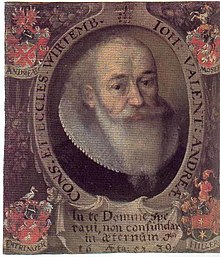Church Convention
The church convention was a communal moral court in Württemberg between 1642 and 1891.
The church convention was established in the Thirty Years' War by regulation of Duke Eberhard III. of July 29, 1642 in the official cities of the Duchy of Württemberg, 1644 also introduced in the other communities. The initiative came from Johann Valentin Andreae from which the idea of his stay in the Calvinist influenced Geneva had brought in 1610th His aim was to improve the morals that had decayed during the Thirty Years War.
The convent was led jointly by the mayor as the secular and by the pastor as the spiritual head of the community. In the regional and administrative towns, this task lay with Vogt and Spezial ( dean ). Other members were the nurse of the saints and at least one assessor from among the community members. Defense counsel for the summons was not permitted. As a rule, meetings took place once a month on a Sunday after the service in the council or rectory.
Offenses against ecclesiastical order (e.g. obligation to attend church services and communion, prohibition of Sunday work, discipline in worship), against the prevailing sexual morality (e.g. premarital and extramarital sexual intercourse and pregnancy) and other regulations, e.g. dancing, were negotiated . Concerning drinking, playing and swearing. The Convention could bid or arrest penalties imposed. Anyone who reported an offense that was punished with a fine received a third of the fine as a reward ( third ).
Minutes were drawn up of the meetings and resolutions. Church convention protocols are an important source of cultural and moral history from the 17th to 19th centuries, especially for rural areas.
After the territorial expansion of Württemberg from 1803, the church conventions were also introduced in the newly acquired areas. There were then both Protestant and Catholic church conventions. Under King Wilhelm I , the church conventions were given additional tasks in the field of poor and welfare work.
The church conventions existed until 1891. They were abolished by the law of May 21, 1891. Their tasks were assigned to the respective local councils and parish councils .
Sources and Notes
- ↑ Printed in: August Ludwig Reyscher : Complete, historical and critically edited collection of Württemberg laws. Volume V . 1991, p. 427ff
- ↑ Printed in: Württembergisches Regierungsblatt No. 14/1891 (p. 103ff)
literature
- Alfred Dehlinger: The church convents from 1642 to 1891. In: Alfred Dehlinger: Württembergs Staatswesen. Volume 1. Stuttgart 1951, pp. 281f
- Beate Popkin: The church convention in Württemberg . In: Leaves for Württemberg Church History 96 . 1996, pp. 98-118
- Hermann Ehmer, Sabine Holtz (ed.): The church convent in Württemberg. Sources and research on the Württemberg church history 21. Epfendorf / Neckar 2009.
